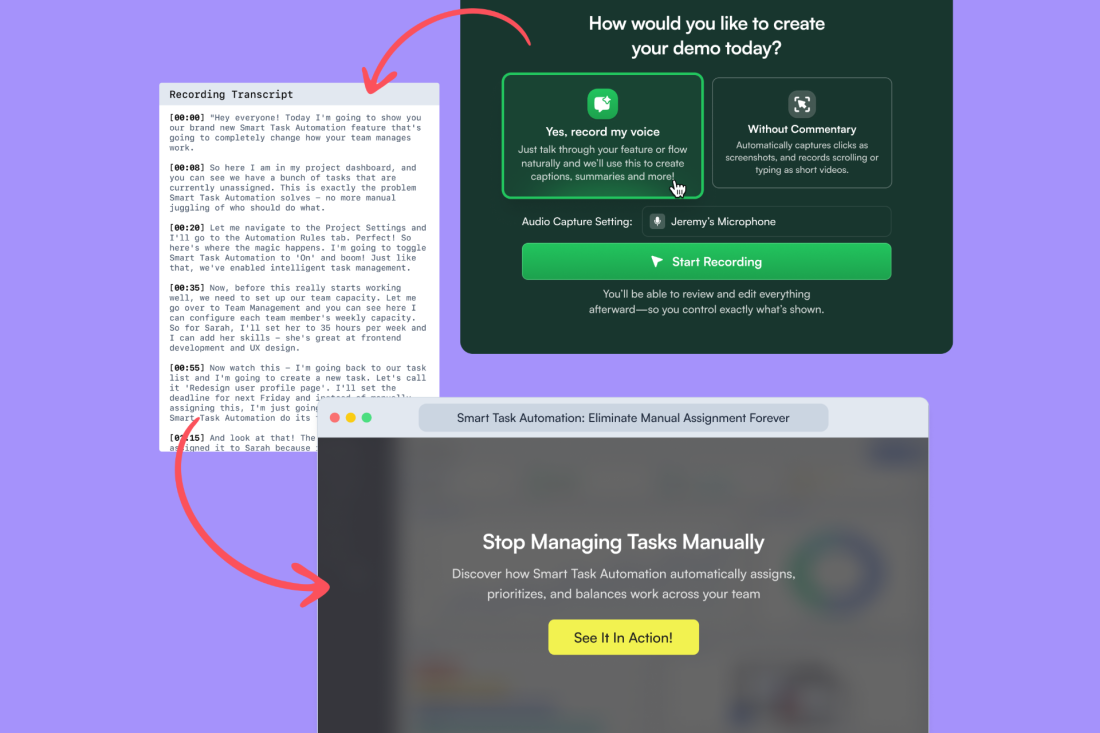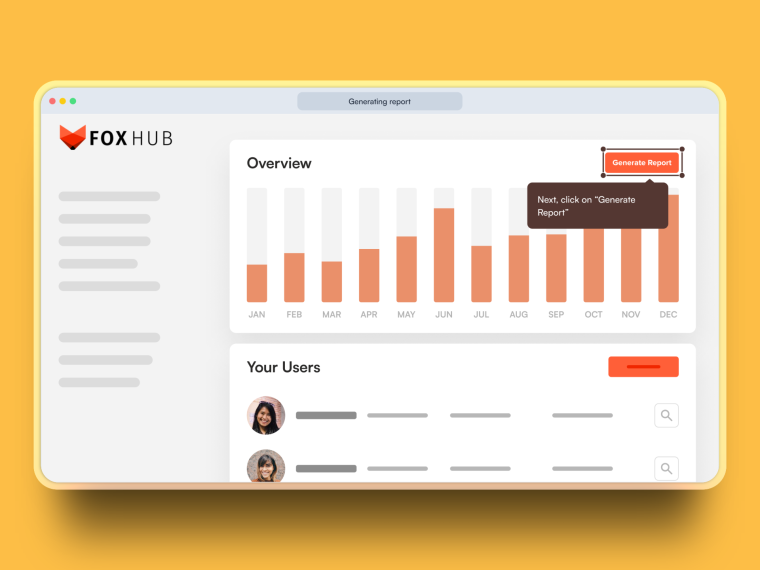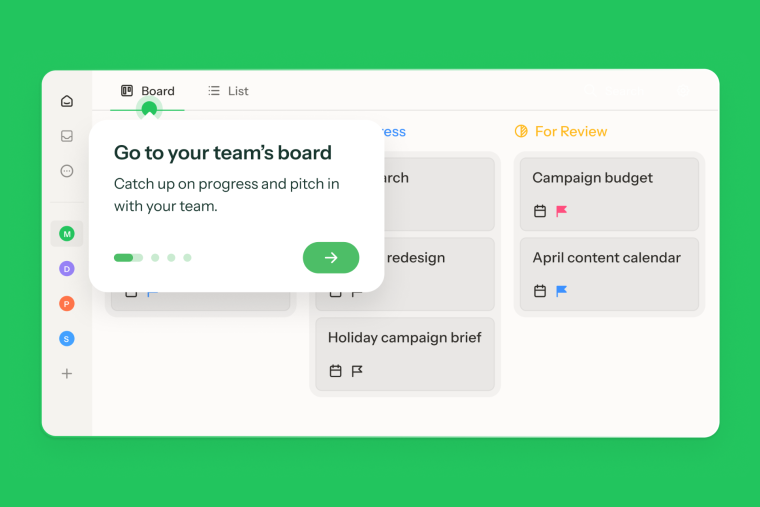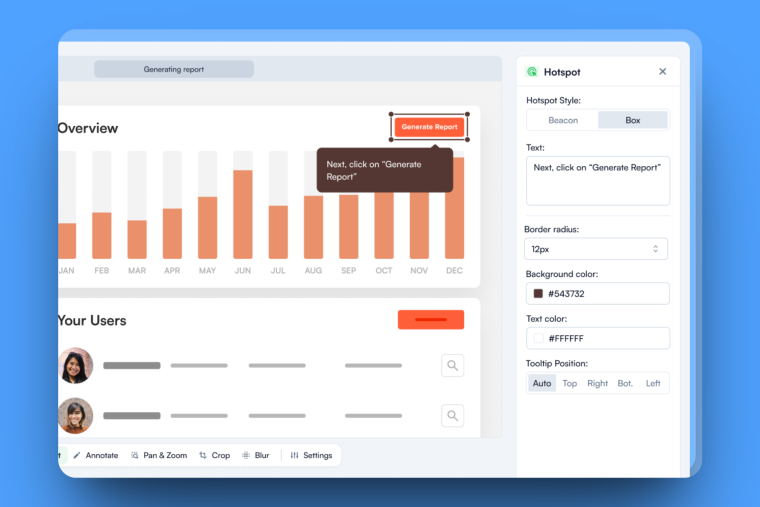Product and growth teams face mounting pressure to deliver seamless onboarding, accelerate time-to-value, and prove ROI at every turn. Yet traditional product demos—static videos, generic click-throughs, one-size-fits-all walkthroughs—consistently fall short, leaving users disengaged and adoption metrics stagnant.
The solution isn't just better demos. It's intelligent, adaptive experiences that meet users where they are and guide them toward value. AI interactive demos represent a fundamental shift in how SaaS companies onboard, educate, and convert users—transforming passive viewing into active engagement and measurable product adoption.
This guide explores how AI-powered interactive demos are reshaping product adoption, what sets the leading platforms apart, and how to strategically implement them for business impact that shows up in your metrics.
What Are AI Interactive Demos?
AI interactive demos are dynamic, guided product experiences that leverage artificial intelligence to personalize, automate, and analyze user engagement. Unlike static video walkthroughs or generic click-throughs, AI demos adapt in real time—responding to user actions, tailoring content to specific segments, and surfacing insights that drive continuous improvement.
From Static to Smart: The Evolution of Product Demos
The journey from static demos to AI-powered experiences mirrors the evolution of SaaS itself. Early demos were linear, one-size-fits-all videos or slide decks that treated every user the same. Today's AI-driven interactive demos utilize machine learning to identify user intent, automate hotspot creation, and generate supporting assets, such as product tours, micro-surveys, and go-to-market collateral—all from a single recording.
Key Differentiators
Personalization: AI tailors demo flows based on user role, industry, or behavior, ensuring relevance and higher engagement. An admin sees different features than an end-user, and a marketing team member gets a different experience than someone in sales.
Automation: Modern platforms can automatically detect key UI elements, create interactive hotspots, and assemble campaign kits—including product tours, surveys, and GTM messaging—at scale. What used to take hours of manual work now happens in minutes.
Analytics: Deep, actionable analytics track every interaction, revealing drop-off points, feature interest, and conversion triggers. You're not just measuring views—you're tracking what users actually do after the demo.
Concrete Examples
Consider a SaaS onboarding demo that adapts its flow for admins versus end-users, highlighting only the most relevant features for each role. Or automated hotspot creation, where AI scans your UI and suggests the optimal points for user guidance—no manual tagging required. The most advanced platforms generate instant campaign kits, including the demo itself, a ready-to-launch product tour, a micro-survey, and GTM copy (emails, messaging, and positioning documents) to support your launch.
Addressing Misconceptions
AI interactive demos aren't just for technical teams or enterprise budgets. Today's platforms are designed for product managers and growth teams—no coding required, with intuitive editors and seamless integrations. The barrier to entry has never been lower, and the potential impact has never been higher.
The Business Impact: Why AI Interactive Demos Drive Product Adoption
AI interactive demos aren't just a shiny new tool—they're a proven lever for SaaS growth. The data tells a compelling story.
Quantified Benefits
Engagement: Interactive demos consistently see 60–80% higher engagement rates than static content, as users are guided through relevant, hands-on experiences rather than passively watching videos.
Conversion: Companies report 20–40% increases in trial-to-paid conversions when using AI-powered demos, thanks to faster time-to-value and reduced friction in the onboarding journey.
Efficiency: AI automation slashes demo creation time by up to 80%, freeing product and growth teams to focus on strategy and optimization rather than manual setup and maintenance.
Connection to Key SaaS Metrics
Activation Rate: Personalized demos accelerate user activation by showing the right features at the right time, helping users reach their first "aha" moment faster.
Time-to-Value: Automated, contextual guidance helps users realize value faster, reducing onboarding drop-off and improving retention from day one.
Churn Reduction: Ongoing, data-driven demo experiences keep users engaged and informed throughout their lifecycle, lowering the risk of churn by ensuring they understand and use the features that matter most.
AI Demos vs. Traditional Onboarding
Traditional onboarding often relies on static guides or generic tours, which can overwhelm or bore users. They're built once and shown to everyone, regardless of role, experience level, or goals. AI interactive demos, by contrast, adapt to each user's journey—delivering just-in-time guidance and surfacing actionable insights for continuous optimization. The difference shows up in your activation rates, conversion metrics, and ultimately, revenue.
Chameleon: AI Interactive Demos That Connect to Product Adoption
While many platforms focus on creating standalone demos for marketing and sales, Chameleon takes a fundamentally different approach: connecting demos directly to in-product experiences and tracking what users actually do, not just what they view.
Why Chameleon Is an AI Interactive Demo Platform
Chameleon's AI-powered demos are built for product teams who care about adoption, not just impressions. Here's what sets the platform apart:
AI Creation from Voice
Talk through a feature like you would to a teammate. Chameleon's AI handles the demo, hotspots, chapters, and CTAs automatically. No typing, no manual annotation—just natural explanation that gets transformed into an interactive experience.
From Demo to Done: Campaign Kits
From one recording, Chameleon's AI creates everything you need for launch: your demo, an in-app tour, a micro-survey, help doc copy, and other marketing materials. Review, tweak, and publish—all from a single workflow. This isn't just demo creation; it's a complete launch system.
Pre-Signup Tracking That Follows Through
Chameleon merges anonymous demo engagement with signed-in user profiles, then uses that data to target tours and nudges that hit home. You can see exactly who engaged with your demo before signing up, and tailor their in-product experience accordingly.
See Impact, Not Impressions
Tie each demo to a measurable product outcome—account creation, feature activation, or any custom milestone—then track who follows through in your product. Demo Goals connect viewing behavior to real adoption metrics, proving ROI in a way that view counts never could.
Turn Demo Views into In-App Audiences
Build audiences of demo engagers and target them across your product to guide them toward their next best step. Someone who completed a demo on advanced reporting? Automatically enroll them in a guided tour of analytics features, followed by a micro-survey to capture feedback.
A/B Testing Without the Heavy Lifting
Test different demo lengths, content, and copy to see what drives users to deeper product adoption. Chameleon's built-in A/B testing makes optimization straightforward, with clear data on what works.
Seamless Integration with In-App Experiences
Chameleon's demos aren't isolated assets—they're part of a holistic product adoption platform that includes tours, tooltips, surveys, launchers, and analytics. This means your demo strategy connects directly to onboarding flows, feature announcements, and ongoing user education. It's the difference between a marketing tool and a product adoption system.
Free Plan, No Catch
Chameleon offers a free plan (not a trial) with unlimited demos, unlimited seats, engagement tracking, and email capture. For teams just starting with interactive demos, it's a zero-risk way to prove value before committing to paid features like AI creation, campaign kits, and in-app goal tracking.
As Batikan Erdogan, Head of Growth & Conversion Systems at Chili Piper, puts it:
"The Demos look amazing! Plus, having full flexibility to leverage user and company properties to engage viewers is HUGE."
2025's Leading AI Interactive Demo Platforms: Comprehensive Comparison
Choosing the right AI interactive demo platform is critical. Here's a side-by-side look at the top solutions for SaaS teams in 2025:
Platform | AI Features | Best For | Starting Price |
|---|---|---|---|
Chameleon | AI voice creation, campaign kits, and in-app goal tracking | Product adoption & onboarding | Free to create unlimited Demos; add-on for AI features |
Supademo | AI-guided flows, auto-step detection | Fast onboarding demos | Free tier: up to 5 published demos |
Storylane | AI screen capture, smart branching | Sales enablement | Free/basic: limited features (1 published demo) |
Fable | AI-driven personalization, analytics | Product-led sales/marketing | Solo/Free: limited / single-demo access |
Arcade | AI-powered hotspots, embeddable demos | Marketing, self-serve | Free: up to 3 published demos with watermark |
Navattic | AI step suggestions, analytics integrations | Product marketing | Free to create one demo • Starts at ~$500/month for base package |
Reprise | Advanced AI, deep analytics, enterprise integrations | Complex SaaS, enterprise | Custom |
Chameleon leads in integration depth and product adoption focus, with AI that generates complete campaign kits and tracks in-app outcomes. The free plan makes it accessible to teams of any size, while paid features unlock advanced AI creation and goal tracking.
Supademo offers rapid demo creation with AI-guided flows, ideal for teams prioritizing speed in onboarding use cases.
Storylane excels in sales enablement, using AI for smart branching and screen capture that adapts to prospect behavior.
Fable focuses on product-led sales and marketing, with strong AI personalization and analytics for growth teams.
Arcade is best for marketing teams needing embeddable, AI-powered demos that live on websites and landing pages.
Navattic stands out for product marketing, with AI step suggestions and analytics integrations that connect to broader campaigns.
Reprise is for enterprise SaaS, offering advanced AI and deep integration capabilities for complex products and large organizations.
The key differentiator: most platforms focus on demo creation for marketing and sales. Chameleon connects demos to in-product experiences and tracks what users actually do—making it the only platform built specifically for product adoption, not just lead generation.
Strategic Selection Framework: Choosing Your AI Demo Platform
Selecting the right AI interactive demo tool is a strategic decision that impacts your entire adoption ecosystem. Here's a five-step framework to guide your evaluation:
1. Integration Requirements
Assess how well the platform connects with your existing stack—CRM, product analytics, onboarding tools, and customer data platforms. Deep integrations enable richer personalization and more actionable insights. Can the platform pass demo engagement data to your analytics tool? Can it trigger in-app experiences based on demo behavior? These connections determine whether your demo strategy lives in isolation or becomes part of a unified adoption system.
2. Customization and Branding
Look for tools that allow full control over demo appearance, messaging, and user flows. Your demo should feel like a natural extension of your product, not a generic overlay with someone else's branding. Can you match your design system? Can you customize every piece of copy? Can you control the exact flow and branching logic? The best demos are invisible—they feel like part of the product itself.
3. Analytics Depth and Actionability
Prioritize platforms with robust analytics that go beyond view counts. Track engagement, drop-off points, and feature interest. But more importantly, track what happens after the demo. Do viewers sign up? Do they activate? Do they adopt specific features? Actionable data is key to optimizing both demos and broader adoption strategies. If you can't connect demo behavior to product outcomes, you're flying blind.
4. Scalability and Team Collaboration
Consider how the platform supports multiple teams, roles, and use cases. Features like version control, permissions, and collaborative editing are essential for growing SaaS organizations. Can your product team create demos while your marketing team embeds them? Can you maintain brand consistency across dozens of demos? Can you iterate quickly without breaking existing implementations? Scalability isn't just about pricing—it's about workflow.
5. Total Cost of Ownership
Factor in not just subscription fees, but also implementation time, support, and potential integration costs. Calculate ROI based on time saved, conversion uplift, and reduced churn. A free or low-cost tool that requires extensive manual work may cost more in the long run than a premium platform that automates creation and optimization. Consider the full picture: what does it cost to create, maintain, and optimize your demos over time?
Actionable Tools
Download an evaluation checklist that covers all five criteria. Use an ROI calculation framework to compare platforms based on your specific metrics. Follow an implementation timeline template to plan your rollout and measure success at each stage.
Implementation Excellence: Best Practices for High-Converting AI Demos
To maximize the impact of your AI interactive demos, follow this four-pillar framework:
1. Narrative Design
Craft a story-driven demo that guides users through key value moments. Don't just show features—show outcomes. Use branching logic to adapt the narrative based on user role or intent. An admin should see how the product saves their team time; an end-user should see how it makes their daily work easier. The best demos feel like a conversation, not a feature tour.
2. Personalization Strategy
Leverage AI to segment users and deliver dynamic content. Trigger personalized flows based on user actions, lifecycle stage, or product usage data. Someone who's never logged in needs a different demo than someone who's been using the product for months. Use behavioral data to show relevant features at the right time, and adjust the demo length and depth based on engagement signals.
3. Performance Optimization
Implement A/B testing to refine demo steps, messaging, and CTAs. Use analytics to identify drop-off points and iterate quickly. Test different demo lengths—sometimes shorter is better, sometimes users want depth. Test different CTAs—does "Start Free Trial" convert better than "See It in Action"? Test different entry points—does the demo work better on the homepage or in the product? Let data drive your decisions.
4. Integration Orchestration
Ensure a seamless handoff from demo to in-product experience. Connect demo insights to onboarding flows, tooltips, and micro-surveys for continuous engagement. If someone completes a demo on advanced features, don't make them hunt for those features in the product—guide them there automatically. Use demo engagement data to personalize the entire user journey, from first touch to full adoption.
Practical Guidelines
Keep demos concise: 3–5 minutes is optimal for complex SaaS products. Attention spans are short, and users want to get to value quickly.
Use personalization triggers (e.g., user role, industry, company size) to tailor content. A 10-person startup needs different guidance than a 1,000-person enterprise.
Set up analytics to track completion rates, feature interest, and conversion. But don't stop there—track what users do after the demo. That's where the real insights live.
Chameleon in Action
Chameleon's AI not only creates interactive demos but also automatically generates campaign kits—including product tours, micro-surveys, and GTM assets—so you can launch, measure, and optimize faster. The platform's integration with in-app experiences means demo insights feed directly into personalized onboarding flows. For example, a user who completes a demo on advanced reporting can be automatically enrolled in a guided tour of analytics features, followed by a micro-survey to capture feedback. It's a closed loop from demo to adoption.
Beyond Demos: Integrating AI Experiences into Your Product Adoption Ecosystem
AI interactive demos are most powerful when embedded within a holistic product adoption journey. Think of demos not as standalone assets, but as one touchpoint in a continuous user experience.
Strategic Integration Model
Pre-Trial: Use AI demos to educate and qualify leads before they sign up. Embed demos on your homepage, pricing page, or in nurture emails to help prospects self-qualify and understand value before talking to sales.
Demo: Deliver personalized, interactive experiences that showcase value based on user role, industry, or stated goals. Capture engagement data to inform the next steps.
Trial: Transition users seamlessly into in-app onboarding, leveraging demo insights to personalize their first experience. If they engaged heavily with a specific feature in the demo, make sure that feature is front and center when they log in.
Onboarding: Guide users with contextual product tours, tooltips, and micro-surveys that build on what they learned in the demo. Don't make them relearn—build on their existing knowledge.
Adoption: Use analytics to identify power users, surface new features, and reduce churn. Continue using demos to educate users about advanced features or new releases throughout their lifecycle.
Step-by-Step Implementation Guide
Map the user journey from first touch to full adoption. Identify where demos fit and what role they play at each stage.
Define data flows between demo, onboarding, and analytics tools. What data needs to pass between systems? How will you use demo engagement to trigger in-app experiences?
Set success metrics for each stage (e.g., demo completion rate, activation rate, feature adoption rate). Connect these metrics to business outcomes like conversion, retention, and expansion.
Seamless Demo-to-Product Transitions with Chameleon
Chameleon's AI enables automatic creation of hotspots and campaign kits, ensuring that demo insights feed directly into personalized onboarding flows. The platform's identity resolution merges anonymous demo engagement with signed-in profiles, so you can track users from first demo view through full product adoption. This continuity is what separates a demo tool from a product adoption platform.
Case Study Framework
Track the progression: Demo → Guided tour → Feature adoption. Measure user engagement and conversion at each stage. Identify where users drop off and optimize accordingly. The goal isn't just demo completion—it's product adoption.
Measuring Success: Analytics and Optimization Strategies
To prove the ROI of AI interactive demos, focus on these key performance indicators:
Demo Engagement Rate: Percentage of users who complete the demo. This tells you if your demo is compelling and well-designed.
Activation Rate: Percentage of demo users who reach key value milestones in the product. This tells you if your demo is driving real adoption.
Conversion Rate: Percentage of demo users who become paying customers. This is the ultimate measure of demo effectiveness.
Time-to-Value: Average time from demo to first value action. Shorter is better—it means your demo is accelerating the user journey.
Churn Reduction: Retention rates among demo-engaged users compared to non-demo users. This tells you if demos are creating stickier, more engaged users.
Advanced Analytics Setup
Integrate demo analytics with product analytics platforms for a unified view. Use cohort analysis to compare outcomes for demo versus non-demo users. Set up automated alerts for drop-off or high-converting segments so you can respond quickly to changes in user behavior.
Optimization Strategies
Regularly review analytics to identify friction points. Where do users drop off? What features generate the most interest? What CTAs drive the most conversions? Iterate demo flows based on user feedback and behavioral data. Align demo KPIs with broader product adoption metrics for holistic optimization. The best teams treat demos like they treat product features—constantly testing, learning, and improving.
Future-Proofing Your Demo Strategy: 2025 Trends and Beyond
The future of AI interactive demos is bright—and fast-evolving. Here's what to watch:
Emerging Capabilities
GPT Integration: Natural language guidance and real-time Q&A within demos. Imagine users asking questions during a demo and getting instant, contextual answers powered by AI.
Voice Interaction: Hands-free, conversational demo experiences that feel more like a guided tour than a click-through.
Predictive Personalization: AI that anticipates user needs and adapts flows on the fly, showing the next best feature before users even ask for it.
Industry Evolution
Demos will become more deeply embedded in the product experience, blurring the line between onboarding and ongoing education. Expect tighter integration with analytics, CRM, and customer success platforms. The distinction between "demo" and "product" will fade as experiences become more fluid and adaptive.
Preparation Strategies
Invest in platforms with open APIs and robust integration ecosystems. The tools that win will be the ones that play well with others. Build a culture of experimentation—test new AI features and measure impact. Stay agile: regularly review your demo and onboarding strategy to keep pace with user expectations and technology advances. The teams that win in 2025 and beyond will be the ones that treat demos as a strategic asset, not a one-time project.
Conclusion
AI interactive demos are no longer a "nice-to-have"—they're a strategic imperative for SaaS teams aiming to accelerate product adoption, boost engagement, and drive measurable business outcomes. By combining intelligent automation, deep personalization, and actionable analytics, today's leading platforms empower product managers to deliver onboarding experiences that convert and retain users at scale.
But the key is to think beyond demo creation. The most successful teams integrate AI demos into their broader adoption ecosystem, measure what matters, and iterate relentlessly. They don't just track views—they track activation, conversion, and retention. They don't just create demos—they create connected experiences that guide users from first touch to full adoption.
Chameleon's approach—connecting demos to in-app experiences and tracking what users actually do—represents the next generation of product adoption tools. It's not about creating flashy assets for the homepage. It's about building a system that meets users where they are, guides them toward value, and proves impact in the metrics that matter.
The future of product adoption is interactive, intelligent, and—most importantly—user-centric. The question isn't whether to invest in AI interactive demos. It's whether you can afford not to.






